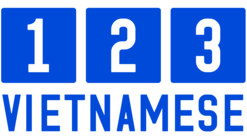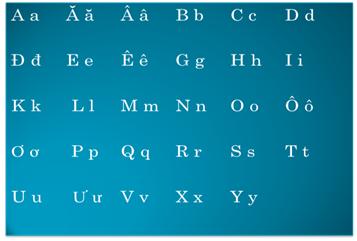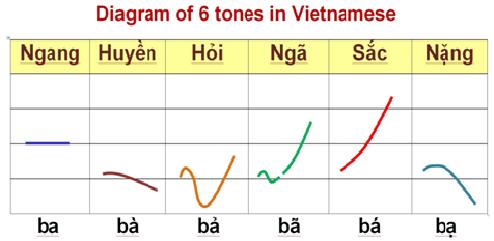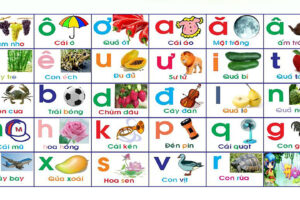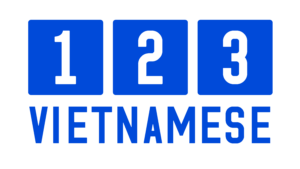
Learning Vietnamese for Beginners: Is it Difficult or Easy?
If you are a foreigner and you love Vietnamese language, I think this blog is the right place for you to reach. I’m a Vietnamese; I used to ask How to learn vietnamese language step by step when I was a child, and now I work as a Vietnamese teacher on 123vietnamese.com. Although I can’t say I am an expert at my mother tongue, I’m quite sure that I know some things about it. Because of the suggestion from some students, I’ve just made up my mind writing this blog to bring up a controversial question: Is learning Vietnamese easy or difficult?
“Study Vietnamese is not easy but fun.”
That’s a correct statement. I myself think that Vietnamese is easy enough for a foreigner to learn to speak. Why can I say that? Here are the reasons:
Why Vietnamese language is not difficult to learn
1. It’s simple to learn to speak and to read Vietnamese.
Vietnamese language belongs to the category of phonetic script, which means that a letter is uttered by one sound, or I can say that a word in Vietnamese only contains one syllable. This feature is different from English or French because a word (or words) in these languages may have more than one syllable. Let’s have a look at the word “mẹ” below:
| Ngôn ngữ | Từ | Phát âm |
| Tiếng Việt | mẹ | mẹ |
| Tiếng Hoa | 母親 | mǔqīn |
| Tiếng Anh | mother | /ˈmʌðə/ |
The difference seems to be hard at first, but when you put it into practice, it turns out very easy because nothing can be simpler than the system of one word – one sound.After a short term of learning pronunciation, you will know how to speak out a word by combining a consonant, a vowel with a tone. Actually, some of my Turkish students told me that it is possible for them to read a full text fluently without understanding the meaning of it. They may make boast of their ability, but indeed they can do it quite well. Learning to speak Vietnamese is sure easy.
2. The Vietnamese alphabet looks similar to the ones of English, French or other Western countries.
Obviously, this is one of the advantages of Vietnamese because most foreigners will find it easy to learn Vietnamese alphabet on the first day of the beginner’s class. There are 29 letters in Vietnamese alphabet, which is based on Latin alphabet. As long as you learn by heart these letters, you will make progress on learning new vocabulary later. Here are 29 letters in the alphabet:
3.Vietnamese grammar is said to be very simple.
Mr. David, an English teacher and a student of mine, said that, “Vietnamese is a quickly spoken language.I am quite happy verbs have no tenses.” In my opinion, Vietnamese grammar is actually more complicated than English grammar, but when it comes to daily communication, you just simply learn some simple structures from the dialogues in the textbooks and that’s enough. There are no tenses, no verb forms, no plural rules. Thanks to the simple grammar, lots of my students can use Vietnamese to communicate after one month of study. Though there are more personal pronouns in Vietnamese than in English or French, they are easily matched to family relationships. If they make you confused, I recommend drawing a family tree and adding the Vietnamese personal pronouns to help simplify and clarify.
Some Obstacles that learners will go through
“Finding the motivation.”
This is certainly a complaint of a foreigner who has to study Vietnamese language due to the requirement of his job. Although I do not completely agree with him, I have to accept that there are still some obstacles that learners will go through.
Vietnamese Tones
At first, as you can see Vietnamese is a tonal language, and tone is an indispensable part in the syllable structure. As you know, There are 6 tones in the Vietnamese language and they are named differently. They are: ngang, huyền, sắc, nặng, hỏi, ngã. Let’s have a look at the diagram below:
To some of my foreign students, especially students from Western countries such as Britain, France, America, one of the major barriers they must get over is to use and pronounce the tones correctly because their first languages are non-tonallanguages. Changing the tones of a word means that you are going to have a new word with different meaning as well. And sometimes making a false tone can create an awkward situation. Let me tell you a real story that I collected from the internet.
Once, a Korean girl student said to her Vietnamese friend. Korean girl: “Hôm qua, em bị ôm. (Yesterday, I was hugged.). Her Vietnamese friend anxiously asked, “Em bị ôm ở đâu?” (Where were you hugged?). She replied, “Dạ ở ký túc xá.” (In the dorm). He continued, “Em đã báo bảo vệ chưa?” (Have you reported to the security guard?). And she answered, “Em đã đến bác sĩ rồi.” (I went to see the doctor already.)
Well, it turns out that instead of saying “bị ốm” (be sick), the Korean student pronounced “bị ôm” (be hugged). She only forgot to pronounce the tone “sắc”, but the whole story went wrong.
Vietnamese vocabulary
Next, it is a big mistake if I don’t mention the ampleness of Vietnamese vocabulary as another big issue for some foreign students. As you can notice, Vietnamese language has a lot of homophones which can make you misunderstand what others want to say. For example: Con ruồi đậu mâm xôi đậu. The first “đậu” is a verb, which means “to land, to alight”, but the second “đậu” is a noun, which means “a bean”. The sentence should be translated into: “The fly sits on the dish of bean sticky rice.” Furthermore, Vietnamese has not only lots of homophones, but also plenty of synonyms. The use of each synonym is dependent on a few aspects such as the particular situations, the culture of different regions, the relationship between the speaker and listener, and so on. For instance, “father” in Vietnamese is “ba, bố, cha, tía, thầy; or “die” in Vietnamese can be expressed as “chết, qua đời, từ trần, băng hà, hy sinh”. How to use a right word in a particular situation is another big question that I may discuss in another blog.
Lexical structure of Vietnamese
Finally, the lexical structure of Vietnamese is also a problem I’d like to mention as a difficulty that many students often encounter during their learning process. In Vietnamese, a different word ordercan lead you to a different things or people. Let’s see this example:
1. con thỏ (a rabbit) – thỏ con (a bunny)
2. bạn của mẹ (a friend of the mother) – mẹ của bạn (a mother of the friend) – của bạn mẹ (belong to the mother’s friend) – của mẹ bạn (belong to the friend’s mother)
It’s a bit confused and you should learn them unless you want to get caught in an embarrassing situation. Besides, the noun phrase structure in Vietnamese language is not the same asthe one in English. Normally, the important part or the noun will be placed on the front,and the adjective (or may be described as complementary) will be putafter the noun. So we have this order:
Noun phrase | Meaning | |
| Noun | Adjective | |
| bầu trời | xanh biếc | a very blue sky |
| con mèo | đen | a black cat |
| cô bé | dễ thương | a lovely girl |
At this stage, I think you have realized that I don’t aim to answer the question “Is learning Vietnamese easy or difficult?” because it’s not fair for a Vietnamese teacher like me to answer this. I raise this question in order to show you some features of Vietnamese language, especially the advantages and disadvantages that you may deal with to learn Vietnamese well. Despite all difficulties of Vietnamese language, I hope that your learning path will only have fun in the future. Wish you make progress in mastering Vietnamese.
Source : Internet
